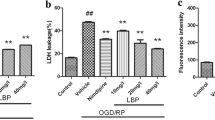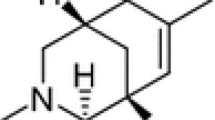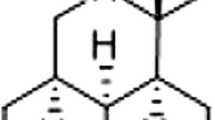Abstract
This study investigated the protective effects of Lycium barbarum polysaccharide (LBP) on alleviating injury from oxygen-glucose deprivation/reperfusion (OGD/RP) in primary cultured rat hippocampal neurons. Cultured hippocampal neurons were exposed to oxygen-glucose deprivation (OGD) for 2 h followed by a 24 h re-oxygenation. The MTT assay and the lactate dehydrogenase (LDH) release were used to determine the neuron viability. Superoxide dismutase (SOD), Glutathione peroxidase (GSH-PX), malondialdehyde (MDA) were determined by spectrophotometry using commercial kits. Mitochondrial membrane potential (MMP) and the intracellular free calcium concentration ([Ca2+]i) in hippocampal neurons were measured using the confocal laser scanning microscope (CLSM). Treatment with LBP (10–40 mg/l) significantly attenuated neuronal damage and inhibited LDH release in a dose-dependent manner. Furthermore, LBP enhanced activities of SOD and GSH-PX but it decreased their MDA content, inhibited [Ca2+]i elevation and decrease of MMP in ischemia–reperfusion treated hippocampal neurons. These findings suggested that LBP may be a potential neuroprotective agent for cerebral ischemia–reperfusion injury.





Similar content being viewed by others
References
Chang RC, So KF (2008) Use of anti-aging herbal medicine, Lycium barbarum, against aging-associated diseases. What do we know so far? Cell Mol Neurobiol 28:643–652
Du G, Liu L, Fang J (2004) Experimental study on the enhancement of murine splenic lymphocyte proliferation by Lycium barbarum glycopeptide. J Huazhong Univ Sci Technolog Med Sci 24(518–520):527
Fein G, Di Sclafani V, Tanabe JL et al (2000) Hippocampal and cortical atrophy predict dementia in subcortical ischemic vascular disease. Neurology 55:1626–1635
Gan L, Zhang SH, Liu Q, Xu HB (2003) A polysaccharide-protein complex from Lycium barbarum upregulates cytokine expression in human peripheral blood mononuclear cells. Eur J Pharmacol 471:217–222
Gong H, Shen P, Jin L, Xing C, Tang F (2005) Therapeutic effects of Lycium barbarum polysaccharide (LBP) on irradiation or chemotherapy-induced myelosuppressive mice. Cancer Biother Radiopharm 20:155–162
Ha KT, Yoon SJ, Choi DY, Kim DW, Kim JK et al (2005) Protective effect of Lycium chinense fruit on carbon tetrachloride-induced hepatotoxicity. J Ethnopharmacol 96:529–535
Hai-Yang G, Ping S, Li JI, Chang-Hong X, Fu T (2004) Therapeutic effects of Lycium barbarum polysaccharide (LBP) on mitomycin C(MMC)-induced myelosuppressive mice. J Exp Ther Oncol 4:181–187
Heiss WD, Thiel A, Grond M, Graf R (1999) Which targets are relevant for therapy of acute ischemic stroke? Stroke 30:1486–1489
Ho Y-S, So K-F, Chang RC-C (2010) Anti-aging herbal medicine. How and why can they be used in aging-associated neurodegenerative diseases? Ageing Res Rev 9:354–362
Honda HM, Korge P, Weiss JN (2005) Mitochondria and ischemia/reperfusion injury. Ann NY Acad Sci 1047:248–258
Hou KA (1984) Dictionary of the families and genera of Chinese seed plants, 2nd edn. Science Press, Beijing
Iijima T (2006) Mitochondrial membrane potential and ischemic neuronal death. Neurosci Res 55:234–243
Iijima T, Mishima T, Tohyama M, Akaqawa K, Iwao Y (2003) Mitochondrial membrane potential and intracellular ATP content after transient experimental ischemia in the cultured hippocampal neuron. Neurochem Int 43:263–269
Jing Z, Yang WU, Sun M et al (2012) Protective effects and mechanisms of OSR on primary cultured hippocampus neurons subjected to anoxic injury in neonatal rat. China J Chin Mater Med 37:1
Jun-rong ZHU, Yi-fu TAO, Shen LOU, Zi-mei WU (2010) Protective effects of ginsenoside Rb3 on oxygen and glucose deprivation-induced ischemic injury in PC12 cells. Acta Pharmacol Sin 31:273–280
Kazda S (1985) Pharmacology of nimodipine, a calcium antagonist with preferential cerebrovascular activity. Neurochirurgia 28:70–73
Kazda S, Towart R (1982) Nimodipine: a new calcium antagonist drug with a preferential cerebrovascular action. Acta Neurochir (Wien) 63:259–265
Li XM, Ma YL, Liu XJ (2007) Effect of the Lycium barbarum polysaccharides on age-related oxidative stress in aged mice. J Ethnopharmacol 111:504–511
Li S-Y, Yang D, Yeung C-M, Yu W-Y, Chang RC-C et al (2011) Lycium Barbarum polysaccharides reduced neuronal damage, blood-retinal barrier disruption and oxidative stress in retinal ischemia/reperfusion injury. PLoS ONE 6(1):e16380
Luo Q, Cai Y, Yan J, Sun M, Corke H (2004) Hypoglycemic and hypolipidemic effects and antioxidant activity of fruit extracts from Lycium barbarum. Life Sci 76:137–149
McCord JM, Fridovich I (1969) Superoxide dismutase. An enzymic function for erythrocuprein (hemocuprein). J Biol Chem 244:6049–6055
Ohkawa H, Ohishi N, Yagi K (1979) Assay for lipid peroxides in animal tissues by thiobarbituric acid reaction. Anal Biochem 95:351–358
Orrenius S, Zhivotovsky B, Nicotera P (2003) Regulation of cell death: the calcium-apoptosis link. Nat Rev Mol Cell Biol 4:552–565
Peng X, Tian G (2001) Structural characterization of the glycan part of glycoconjugate LbGp2 from Lycium barbarum L. Carbohydr Res 331:95–99
Peng X, Huang LJ, Qi CH, Zhang YX, Tian G (2001) Studies on chemistry and immuno-modulating mechanism of a glycoconjugate from Lycium barbarum L. Chin J Chem 19:1190–1197
Reers M, Smith TW, Chen LB (1991) J-aggregate formation of a carbocyanine as a quantitative fluorescent indicator of membrane potential. Biochemistry 30(18):4480–4486
Schaller B, Graf R (2004) Cerebral ischemia and reperfusion: the pathophysiologic concept as a basis for clinical therapy. J Cereb Blood Flow Metab 24(4):351–371
Scriabine A, van den Kerckhoff W (1988) Pharmacology of nimodipine. A review. Ann NY Acad Sci 522:698–706
Shao-Ping Lu, Pin-Ting Zhao (2010) Chemical characterization of Lycium barbarum polysaccharides and their reducing myocardial injury in ischemia/reperfusion of rat heart. Int J Biol Macromol 47:681–684
Szeto HH (2006) Mitochondria-targeted peptide antioxidants: novel neuroprotective agents. AAPS J 8:E521–E531
Towart R, Perzborn E (1981) Nimodipine inhibits carbocyclic thromboxane-induced contractions of cerebral arteries. Eur J Pharmacol 69:213–215
Towart R, Wehinger E, Meyer H, Kazda S (1982) The effects of nimodipine, its optical isomers and metabolites on isolated vascular smooth muscle. Arzneimittelforschung 32:338–346
Wadworth AN, McTavish D (1992) Nimodipine. A review of its pharmacological properties, and therapeutic efficacy in cerebral disorders. Drugs Aging 2:262–286
Wang Y, Zhao H, Sheng X, Gambino PE, Costello B, Bojanowski K (2002) Protective effect of Fructus Lycii polysaccharides against time and hyperthermia-induced damage in cultured seminiferous epithelium. J Ethnopharmacol 82:169–175
Wong CK, Leung KN, Fung KP, Choy YM (1994) Immunomodulatory and anti-tumour polysaccharides from medicinal plants. J Int Med Res 22:299–312
Yu MS, Lai CS, Ho YS, Zee SY, So KF et al (2007) Characterization of the effects of anti-aging medicine Fructus lycii on beta-amyloid peptide neurotoxicity. Int J Mol Med 20:261–268
Zhu XJ, Shi Y, Peng J, Guo CS, Shan NN, Qin P, Ji XB, Hou M (2009) The effects of BAFF and BAFF-R-Fc fusion protein in immune thrombocytopenia. Blood 114(26):5362–5367
Acknowledgments
The study was supported by the National Natural Science Foundation of China (Grant No. 30960506, 81160524). We are indebted to the staff in the animal center and the Science &Technology Centre who provided assistance in the study. The authors would like to thank Dr. Ding-Feng Su, Prof. Zhang Wannian, Miss Wang jie, Miss Wang Shujing and Zhang Yan for their contributions to development and implementation of this study.
Conflict of interest
The authors declare that they have no competing interests.
Author information
Authors and Affiliations
Corresponding author
Additional information
Chen Rui and Li Yuxiang contributed equally to this work.
Rights and permissions
About this article
Cite this article
Rui, C., Yuxiang, L., Yinju, H. et al. Protective effects of Lycium barbarum polysaccharide on neonatal rat primary cultured hippocampal neurons injured by oxygen-glucose deprivation and reperfusion. J Mol Hist 43, 535–542 (2012). https://doi.org/10.1007/s10735-012-9420-4
Received:
Accepted:
Published:
Issue Date:
DOI: https://doi.org/10.1007/s10735-012-9420-4




